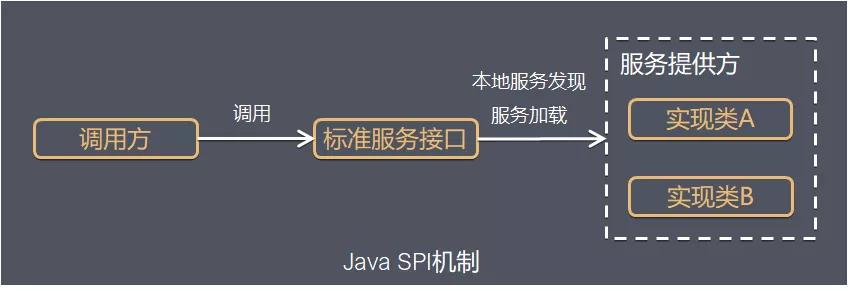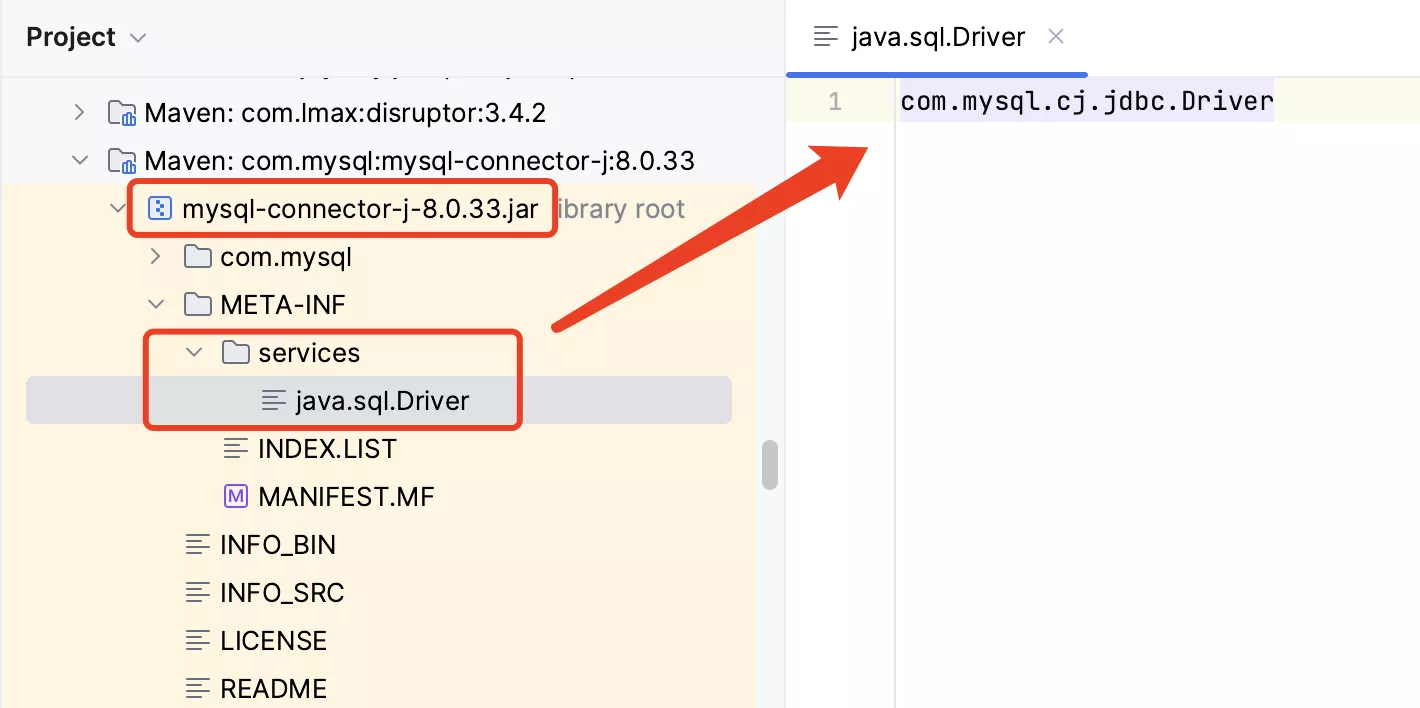- SPI(Service Provider Interface):是JDK内置的一种服务提供发现机制。SPI是一种动态替换发现机制
- eg:有个接口,想运行时动态的给它添加实现,只需要添加一个实现
- 经常遇到的就是
java.sql.Driver接口,不同厂商可以针对同一接口做出不同的实现,Mysql和PostgreSQL都有不同的实现提供给用户,而Java的SPI机制可以为某个接口寻找服务实现

- 如上图所示,接口对应的抽象SPI接口;实现方实现SPI接口;调用方依赖SPI接口
- SPI接口的定义在调用方,在概念上更依赖调用方;组织上位于调用方所在的包中,实现位于独立的包中
- 当服务的提供者提供了一种接口的实现后,需要在
classpath下的META-INF/services/目录里创建一个以服务接口命名的文件,内容就是这个接口具体的实现类 - 当其他程序需要这个服务时,可以通过查找
META-INF/services/接口全路径名文件中的实现类全路径名,根据全路径类名进行加载实例化。JDK中查找服务实现的工具类是:java.util.ServiceLoader

- 数据库
DriverManager、Spring、ConfigurableBeanFactory等都用到了SPI机制 DriverManager是JDBC里管理和注册不同数据库driver的工具类。针对一个数据库,可能会存在着不同的数据库驱动实现。在使用特定的驱动实现时,不希望修改现有的代码,而希望通过一个简单的配置就可以达到效果- 在使用Mysql驱动时,
DriverManager是怎样获得某确定驱动类的?在运用Class.forName("com.mysql.jdbc.Driver")加载Mysql驱动后,就会执行其中的静态代码把driver注册到DriverManager中,以便后续使用
spring:
datasource:
username: root
password: ******
driver-class-name: com.mysql.cj.jdbc.Driver
url: jdbc:mysql://ip:port/mca?serverTimezone=UTC&useUnicode=true@characterEncoding=utf-8&zeroDateTimeBehavior=CONVERT_TO_NULL
@ConfigurationProperties(prefix = "spring.datasource")
public class DataSourceProperties implements BeanClassLoaderAware, InitializingBean {
private String name;
private Class<? extends DataSource> type;
private String driverClassName;
private String url;
private String username;
private String password;
}
abstract class DataSourceConfiguration {
@Configuration(proxyBeanMethods = false)
@ConditionalOnClass(HikariDataSource.class)
@ConditionalOnMissingBean(DataSource.class)
@ConditionalOnProperty(name = "spring.datasource.type", havingValue = "com.zaxxer.hikari.HikariDataSource",
matchIfMissing = true)
static class Hikari {
@Bean
@ConfigurationProperties(prefix = "spring.datasource.hikari")
HikariDataSource dataSource(DataSourceProperties properties) {
HikariDataSource dataSource = createDataSource(properties, HikariDataSource.class);
if (StringUtils.hasText(properties.getName())) {
dataSource.setPoolName(properties.getName());
}
return dataSource;
}
}
@SuppressWarnings("unchecked")
protected static <T> T createDataSource(DataSourceProperties properties, Class<? extends DataSource> type) {
return (T) properties.initializeDataSourceBuilder().type(type).build();
}
}
com.mysql.cj.jdbc.Driver.static{}将自身对象注册进DriverManager
package com.mysql.cj.jdbc;
import java.sql.SQLException;
public class Driver extends NonRegisteringDriver implements java.sql.Driver {
static {
try {
java.sql.DriverManager.registerDriver(new Driver());
} catch (SQLException E) {
throw new RuntimeException("Can't register driver!");
}
}
public Driver() throws SQLException {
}
}

DriverManager.static{},用上文提到的SPI工具类ServiceLoader,加载META-INF/services/java.sql.Driver文件,并解析 - 注释“Load these drivers, so that they can be instantiated.”:加载SPI扫描到的驱动来触发他们的初始化。即触发其
static代码块
registerDriver()DriverManager.getConnection()getConnection(String url, String user, String password)
public class DriverManager {
private final static CopyOnWriteArrayList<DriverInfo> registeredDrivers = new CopyOnWriteArrayList<>();
static {
loadInitialDrivers();
println("JDBC DriverManager initialized");
}
private static void loadInitialDrivers() {
String drivers;
try {
drivers = AccessController.doPrivileged(new PrivilegedAction<String>() {
public String run() {
return System.getProperty("jdbc.drivers");
}
});
} catch (Exception ex) {
drivers = null;
}
AccessController.doPrivileged(new PrivilegedAction<Void>() {
public Void run() {
ServiceLoader<Driver> loadedDrivers = ServiceLoader.load(Driver.class);
Iterator<Driver> driversIterator = loadedDrivers.iterator();
try{
while(driversIterator.hasNext()) {
driversIterator.next();
}
} catch(Throwable t) {
}
return null;
}
});
println("DriverManager.initialize: jdbc.drivers = " + drivers);
if (drivers == null || drivers.equals("")) {
return;
}
String[] driversList = drivers.split(":");
println("number of Drivers:" + driversList.length);
for (String aDriver : driversList) {
try {
println("DriverManager.Initialize: loading " + aDriver);
Class.forName(aDriver, true,
ClassLoader.getSystemClassLoader());
} catch (Exception ex) {
println("DriverManager.Initialize: load failed: " + ex);
}
}
}
public static synchronized void registerDriver(java.sql.Driver driver)
throws SQLException {
registerDriver(driver, null);
}
public static synchronized void registerDriver(java.sql.Driver driver, DriverAction da) throws SQLException {
if(driver != null) {
registeredDrivers.addIfAbsent(new DriverInfo(driver, da));
} else {
throw new NullPointerException();
}
println("registerDriver: " + driver);
}
@CallerSensitive
public static Connection getConnection(String url, String user, String password) throws SQLException {
java.util.Properties info = new java.util.Properties();
if (user != null) {
info.put("user", user);
}
if (password != null) {
info.put("password", password);
}
return (getConnection(url, info, Reflection.getCallerClass()));
}
private static Connection getConnection(
String url, java.util.Properties info, Class<?> caller) throws SQLException {
ClassLoader callerCL = caller != null ? caller.getClassLoader() : null;
synchronized(DriverManager.class) {
if (callerCL == null) {
callerCL = Thread.currentThread().getContextClassLoader();
}
}
if(url == null) {
throw new SQLException("The url cannot be null", "08001");
}
println("DriverManager.getConnection(\"" + url + "\")");
SQLException reason = null;
for(DriverInfo aDriver : registeredDrivers) {
if(isDriverAllowed(aDriver.driver, callerCL)) {
try {
println(" trying " + aDriver.driver.getClass().getName());
Connection con = aDriver.driver.connect(url, info);
if (con != null) {
println("getConnection returning " + aDriver.driver.getClass().getName());
return (con);
}
} catch (SQLException ex) {
if (reason == null) {
reason = ex;
}
}
} else {
println(" skipping: " + aDriver.getClass().getName());
}
}
if (reason != null) {
println("getConnection failed: " + reason);
throw reason;
}
println("getConnection: no suitable driver found for "+ url);
throw new SQLException("No suitable driver found for "+ url, "08001");
}
private static boolean isDriverAllowed(Driver driver, ClassLoader classLoader) {
boolean result = false;
if(driver != null) {
Class<?> aClass = null;
try {
aClass = Class.forName(driver.getClass().getName(), true, classLoader);
} catch (Exception ex) {
result = false;
}
result = ( aClass == driver.getClass() ) ? true : false;
}
return result;
}
}
- 先查找
jdbc.drivers属性的值,然后通过SPI机制查找驱动 - 加载
META-INF/services/文件夹下类名为文件名(相当于Driver.class.getName())的资源,加载到JVM
public final class ServiceLoader<S> implements Iterable<S> {
private static final String PREFIX = "META-INF/services/";
private final Class<S> service;
private LinkedHashMap<String,S> providers = new LinkedHashMap<>();
private LazyIterator lookupIterator;
public static <S> ServiceLoader<S> load(Class<S> service) {
ClassLoader cl = Thread.currentThread().getContextClassLoader();
return ServiceLoader.load(service, cl);
}
public static <S> ServiceLoader<S> load(Class<S> service, ClassLoader loader) {
return new ServiceLoader<>(service, loader);
}
private ServiceLoader(Class<S> svc, ClassLoader cl) {
service = Objects.requireNonNull(svc, "Service interface cannot be null");
loader = (cl == null) ? ClassLoader.getSystemClassLoader() : cl;
acc = (System.getSecurityManager() != null) ? AccessController.getContext() : null;
reload();
}
public void reload() {
providers.clear();
lookupIterator = new LazyIterator(service, loader);
}
public Iterator<S> iterator() {
return new Iterator<S>() {
Iterator<Map.Entry<String,S>> knownProviders
= providers.entrySet().iterator();
public boolean hasNext() {
if (knownProviders.hasNext())
return true;
return lookupIterator.hasNext();
}
public S next() {
if (knownProviders.hasNext())
return knownProviders.next().getValue();
return lookupIterator.next();
}
public void remove() {
throw new UnsupportedOperationException();
}
};
}
private class LazyIterator implements Iterator<S> {
Class<S> service;
ClassLoader loader;
Enumeration<URL> configs = null;
Iterator<String> pending = null;
String nextName = null;
private LazyIterator(Class<S> service, ClassLoader loader) {
this.service = service;
this.loader = loader;
}
public boolean hasNext() {
if (acc == null) {
return hasNextService();
} else {
PrivilegedAction<Boolean> action = new PrivilegedAction<Boolean>() {
public Boolean run() { return hasNextService(); }
};
return AccessController.doPrivileged(action, acc);
}
}
private boolean hasNextService() {
if (nextName != null) {
return true;
}
if (configs == null) {
try {
String fullName = PREFIX + service.getName();
if (loader == null)
configs = ClassLoader.getSystemResources(fullName);
else
configs = loader.getResources(fullName);
} catch (IOException x) {
fail(service, "Error locating configuration files", x);
}
}
while ((pending == null) || !pending.hasNext()) {
if (!configs.hasMoreElements()) {
return false;
}
pending = parse(service, configs.nextElement());
}
nextName = pending.next();
return true;
}
public S next() {
if (acc == null) {
return nextService();
} else {
PrivilegedAction<S> action = new PrivilegedAction<S>() {
public S run() { return nextService(); }
};
return AccessController.doPrivileged(action, acc);
}
}
private S nextService() {
if (!hasNextService())
throw new NoSuchElementException();
String cn = nextName;
nextName = null;
Class<?> c = null;
try {
c = Class.forName(cn, false, loader);
} catch (ClassNotFoundException x) {
fail(service, "Provider " + cn + " not found");
}
if (!service.isAssignableFrom(c)) {
fail(service, "Provider " + cn + " not a subtype");
}
try {
S p = service.cast(c.newInstance());
providers.put(cn, p);
return p;
} catch (Throwable x) {
fail(service, "Provider " + cn + " could not be instantiated", x);
}
throw new Error();
}
}
private Iterator<String> parse(Class<?> service, URL u)
throws ServiceConfigurationError
{
InputStream in = null;
BufferedReader r = null;
ArrayList<String> names = new ArrayList<>();
try {
in = u.openStream();
r = new BufferedReader(new InputStreamReader(in, "utf-8"));
int lc = 1;
while ((lc = parseLine(service, u, r, lc, names)) >= 0);
} catch (IOException x) {
fail(service, "Error reading configuration file", x);
} finally {
try {
if (r != null) r.close();
if (in != null) in.close();
} catch (IOException y) {
fail(service, "Error closing configuration file", y);
}
}
return names.iterator();
}
}


